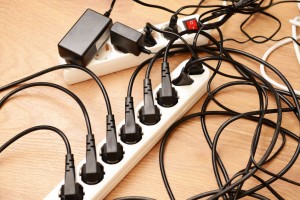 Extension cords are indispensable in many households, and something most of us use without a second thought, but when used improperly, they can cause burns and shocks and start fires. Over 3,000 house fires are started by extension cords each year. Extension cords also pose a tripping hazard, leading to more than half of all extension cord injuries.
Extension cords are indispensable in many households, and something most of us use without a second thought, but when used improperly, they can cause burns and shocks and start fires. Over 3,000 house fires are started by extension cords each year. Extension cords also pose a tripping hazard, leading to more than half of all extension cord injuries.
Extension Cord Safety Tips
- Check the maximum amperage to make sure that your cord can safely power our device. If you plug in a device that uses more amps than the cord can carry, it can cause the cord to overheat or the device to malfunction.
- If you are using the cords outdoors, make sure it is rate for outdoor use, not indoor only.
- Your average household extension cord is meant for occasional, temporary use. If you plan to use the cord frequently or on a continual basis, look for a cord that is designated for this purpose. For instance, the extension cords used on construction sites are designed for continuous use with power tools that draw a lot of amperage.
- Do not continue to use an extension cord that feels hot.
- Do not use an extension cord that is frayed, cracked, or otherwise damaged.
- Do not run the cord across doorways or walkways, where it will pose a tripping hazard.
- So not use nails or staples to secure an extension cord.
- Do not run the cord through water.
- Plug devices in fully, so that the prongs are not exposed.
- Only use cords that have been certified by an independent testing laboratory such as Underwriters Laboratories (UL), Intertek Testing Services (ETL), or Canadian standards Association (CSA).
When your extension cords are not in use, make sure they are safely put away where they will not pose a tripping hazard or get damaged, and preferably out of the sun which can degrade the cord over time. When you get ready to use a cord after storing, inspect it thoroughly for damage, even if it was stored in a safe place.















